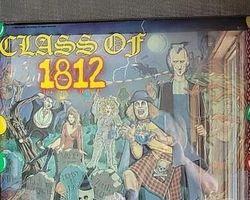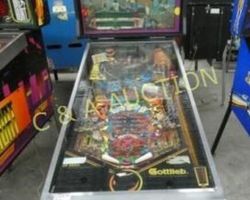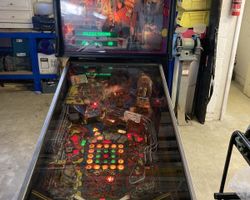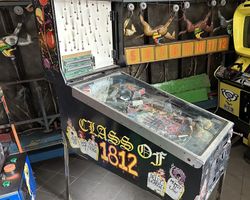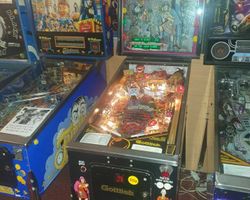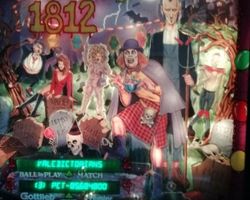Class of 1812
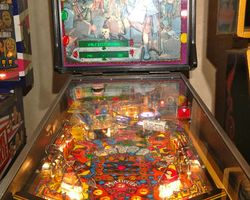
Average Prices: USD $600 to $2,200
Produced: August, 1991
Production Run: 1,668 units
Machine Type: Solid State Electronic
MPU: Gottlieb System 3
Players: 4
Design by: Ray Tanzer, Joe Kaminkow
Art by: Constantino Mitchell, David Moore, Jeanine Mitchell
Premier Technology's "Class of 1812," released in August 1991, entered the pinball landscape with a distinctive and unconventional personality. Manufactured by D. Gottlieb & Co. under their Premier brand, this solid-state electronic (SS) machine, designated Model Number 730, was part of the Gottlieb System 3 generation. With a production run of 1,670 units, the machine's theme diverges from common fantasy or action tropes, delving into a realm of comedy, horror, and supernatural adventure.
The machine’s concept was a collaborative effort, with Joe Kaminkow and Ray Tanzer handling the design. The visual identity of "Class of 1812" was shaped by artists Constantino Mitchell, David Moore, and Jeanine Mitchell, who imbued the game with its peculiar aesthetic. The sound and music, crafted by Dave Zabriskie, played a significant role in defining the machine’s comedic horror atmosphere, notably by incorporating a distinct rendition of Tchaikovsky's 1812 Overture. The choice of "1812" in the title is a deliberate nod to this famous musical composition, humorously integrated with a "class" of ghoulish characters, further amplifying the game's playful absurdity. Its marketing slogan, "Frightful fun for all ages!", encapsulated the lighthearted, accessible nature Gottlieb aimed for.
Signature Features and Design
"Class of 1812" distinguishes itself through a series of memorable and integrated features that amplify its bizarre theme. Central to its identity are two prominent playfield toys: a beating heart and a set of chattering teeth. The beating heart, often illuminated with a red glow, pulses rhythmically, reinforcing the macabre yet comical atmosphere. Adjacent to it, the chattering teeth add a kinetic, humorous element, constantly moving to underline the game's unsettling charm. These physical toys are not merely static decorations; they actively engage the player, contributing to the game's visual and thematic identity.
Beyond the playfield, the backglass of "Class of 1812" features a three-dimensional design, enhancing the visual depth and reinforcing the monster-laden, comedic horror theme. This dimensional effect creates a sense of depth, pulling players further into the game's unique world before the first ball is plunged. The combination of these eccentric toys and the unique backglass design ensures the machine leaves a lasting impression, embodying its "quirky" and "bizarre" reputation.
Playfield and Mechanics
The playfield of "Class of 1812" is designed for energetic gameplay, featuring a conventional two-flipper layout at the bottom and a manual plunger for launching balls. The upper playfield incorporates two ramps that provide primary shot targets, encouraging players to aim for repeatable, satisfying loops. Three pop bumpers, strategically placed, keep the ball lively in the upper regions, contributing to the game's kinetic energy.
A prominent feature of the playfield is the inclusion of eight drop targets. These targets often serve as key objectives, perhaps spelling out words or activating modes when successfully cleared. Spinners are also present, offering satisfying audio-visual feedback when the ball passes through them. The layout, while containing numerous elements, aims for an approachable and swift playing experience. The design philosophy leans towards immediate engagement and fun, with shots that are generally considered accessible, making the game inviting for a wide range of skill levels. The artwork, a frequent topic of discussion among enthusiasts, adorns the playfield with grotesque yet whimsical characters and scenes that align with the machine's campy horror theme. While some find the aesthetic "over-the-top" or "weird," it unequivocally contributes to the machine's singular identity, ensuring a visual experience as distinct as its auditory one.
Gameplay Dynamics
"Class of 1812" embraces straightforward gameplay mechanics, centering around its multi-ball mode and the progression of its unique objectives. The game features a two-ball multiball, which players often find relatively easy to initiate, contributing to a fast-paced and action-oriented experience. This accessibility ensures frequent bursts of chaotic multi-ball play, a core element of the game's entertainment value.
The game's progression, while not deeply intricate, offers distinct challenges. Players typically work towards activating various modes and achieving specific scoring objectives by hitting the primary ramps, drop targets, and other playfield features. A signature gameplay highlight, frequently cited by players, is the activation of the 1812 Overture during multiball, accompanied by the unusual sound of clucking chickens. This auditory experience is a deliberate and humorous design choice, cementing the game’s reputation for bizarre charm. While some find the overall rule set to be less complex than other machines of its era, leading to a perception of simpler gameplay, "Class of 1812" compensates with its immediate playability and entertaining quirks. Strategies often revolve around consistently hitting the multi-ball shot and mastering the flow to maximize scoring opportunities, all while enjoying the game's distinctive sound package.
Reception and Legacy
"Class of 1812" has cultivated a unique position in the pinball community, often eliciting a mixed yet generally positive response. Its primary strength lies in its unusual and campy horror theme, a bold departure from traditional narratives that many players find endearing and humorous. The audio experience is frequently praised, with callouts and the eccentric rendition of the 1812 Overture, complete with chicken clucking, earning particular acclaim for their distinctiveness and comedic timing. The gameplay is often described as fast, fun, and approachable, making it accessible to both experienced players and newcomers. The inclusion of physical toys like the beating heart and chattering teeth, along with the 3D backglass, are consistently highlighted as memorable features that enhance the overall experience.
However, the machine is not without its points of contention. The artwork is a significant area of debate; while some appreciate its "over-the-top" or "weird" aesthetic, others find it "ugly" or "cheesy." This polarizing visual style means it is not universally appealing. Furthermore, the gameplay depth and ruleset are sometimes characterized as simple or repetitive, with the multiball initiation occasionally criticized for being too easy, leading to concerns about long-term replayability in some larger collections. While the audio is generally celebrated, the repetitive nature of certain sounds, such as the chicken clucking, can become grating for some players over extended play sessions. Despite these criticisms, the overall sentiment remains largely positive. "Class of 1812" is frequently described as "fun," "hilarious," and even "addictive" for its unique personality. Its legacy is rooted in its willingness to embrace an unconventional theme and deliver a distinct, humorous experience. It stands as an example of Gottlieb's experimental approach during the System 3 era, proving that a pinball machine can carve out a lasting reputation not just through complex rules or high production numbers, but through sheer charm and a commitment to its singular, bizarre vision.
Sponsored Links
 Ebay Listings
Ebay Listings
 Auction Results
Auction Results
| Cost | Location | Date |
|---|---|---|
| EUR €1,499 |  Czech Republic Czech Republic |
13 May, 2024 |
| USD $4,400 |  New York, United States New York, United States |
22 March, 2024 |
| USD $2,350 |  Indiana, United States Indiana, United States |
16 November, 2023 |
| USD $4,300 |  Tennessee, United States Tennessee, United States |
11 June, 2023 |
| USD $2,450 |  Virginia, United States Virginia, United States |
03 June, 2023 |
| USD $4,000 |  Nebraska, United States Nebraska, United States |
11 December, 2022 |
| GBP £1,760 |  Chertsey, United Kingdom Chertsey, United Kingdom |
23 October, 2022 |
| GBP £1,950 |  Nuneaton, United Kingdom Nuneaton, United Kingdom |
06 October, 2021 |
| USD $2,300 |  Wisconsin, United States Wisconsin, United States |
13 March, 2021 |
| USD $3,250 |  Minnesota, United States Minnesota, United States |
20 August, 2020 |


Private Policy · Search Website · Contact Us
As an eBay Partner, we may earn a commission from qualifying purchases made through links on this site, at no additional cost to you.
All trademarks and copyrighted materials remain property of their respective owners. All other content copyright 2007 - 2025 Pinpedia.

